Episode 197
What you’ll learn in this episode:
- Why all jewelers need to understand the durability of the stones they work with
- How Sally designed her book to be a quick reference for jewelers with minimal gemology knowledge
- Why consumer protections for gemstone quality are lacking, and why jewelers need to take up the mantle for this issue
- What Sally covers in her gemstones for jewelers classes
- Which unusual stones jewelers should take a second look at
About Sally Spencer
Obsessed with jewelry and gemstones, Sally Spencer has been designing and making jewelry since 1995. Her love affair with stones started when she was small, spending many happy hours collecting pebbles on the beach. The stones may have become more expensive over the years, but she is still fascinated by them and has studied both colored stones and diamonds with the Gemological Association of Great Britain (Gem-A). As a Fellow of Gem-A, she continues to love researching about gems and teaching gemstone courses. She is the author of “Jewelers’ Quick Reference Guide to Working with Gemstones,” written specifically for jewelers to live on the bench, ready to answer queries when designing or working on a piece of jewelry.
Additional Resources:
Sally’s Website (Book available on her website)
Photos:
Sally’s Book (available on her website)
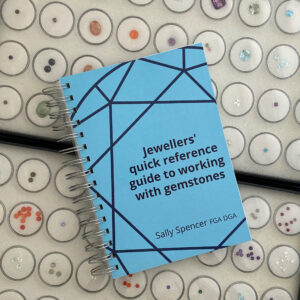
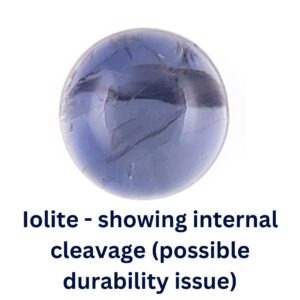
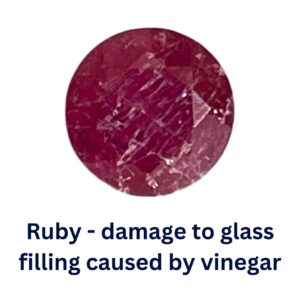
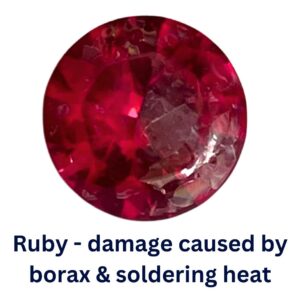
example table page:
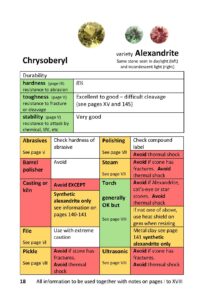
example information page:
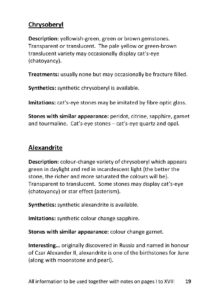
K2 granite with azurite
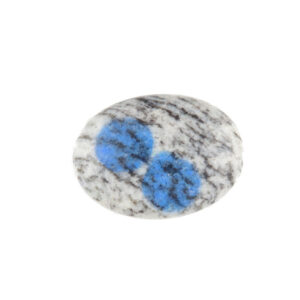
Transcript:
Gemology is such a vast field that it’s impossible for a jeweler to understand everything about the stones they’re working with. That’s where Sally Spencer comes in. As an educator and author, Sally is passionate about teaching jewelers and consumers about the qualities of the stones they’re buying—or think they’re buying. She joined the Jewelry Journey Podcast to talk about the issue with mislabeled synthetic and treated stones; the one thing that every jeweler who works with stones must understand; and why she hopes to see more consumer protections and verification options for gemstones. Read the episode transcript here.
Sharon: Hello, everyone. Welcome to the Jewelry Journey Podcast. This is the second part of a two-part episode. If you haven’t heard part one, please head to TheJewelryJourney.com.
Today, we’re talking with Sally Spencer from the U.K. You may already know Sally if you’re a jeweler, or at least know of her. We are all going to learn about the rest today. Welcome back.
You have different kinds of jewelry on your Facebook page and on your website. Did you design it and then have someone make it or did you actually make it?
Sally: No, I’ve made everything there.
Sharon: There’s a lot. What is the symbolism or the importance of the marine life on everything?
Sally: My happy place is by the sea. I think that has influenced my work. The ammonites I use in my work, I found the originals of those on the beach off the South Coast of England. The others have evolved literally from my love of being by the sea, which is ironic because I live in landlocked Oxfordshire in the middle of England, a long way from the sea.
Sharon: I’m surprised you can still find things on the beach. In California, you don’t find anything except litter. That’s my understanding or my perception of it.
Sally: Particularly at Charmouth, the coast there is being eroded by storms. It’s a clay beach, so every time there’s a really high tide, it washes some of the clay away. That releases more material onto the beach, so it’s continually being topped up with amazing things.
Sharon: Tell us about the classes you teach. What are the subjects and when do you teach them?
Sally: At the moment, I’m concentrating on gemstone classes. I teach in-person gemstones for jewelers classes where we go through a little about what gemstones are, what gemology is. I give them an understanding of that, give them a bit of background on how gemstones react to light, how gemologists use that information. I give them the opportunity to try some of the gemologists’ instruments for themselves, the polariscope, the dichroscope, the spectroscope, so they can have a little flavor, a little feel for how gemologists identify gemstones.
Then we start looking into treatments and imitations and synthetics and man-made stones. I want them to be aware of what’s out there on the market, so they are more aware when they’re shopping and working with stones. I have boxes of stones that I take with me on these courses, so they get a chance to study not just the natural stone, but I also have contrasts. I have a natural and an imitation so they can see them side by side and understand the differences.
I have had so much fun with the online live Zoom classes, particularly with two wonderful ladies in Florida who were an absolute delight. I loved every second of my time with them. We do something similar. Obviously, I can’t do the hands-on bit to show them the gems in person, but I give them an understanding of durability of gemstones, why that’s important, why the correct identification of the gemstone is important. If you don’t know what you’re working with, you don’t know what will or won’t potentially survive while you’re working with it or when the customers are wearing it, and you can’t tell your customer what they’re buying.
I think it’s essential that we take more responsibility for that. In the U.K., we have hallmarking laws where you have to have pieces of jewelry independently assayed to determine exactly what pieces of metal are in there. Then they’re stamped with the appropriate marks to say they’ve been independently attested, and you have the guarantee that’s what the metal is. There’s nothing at all like that for gemstones, so I think it’s important for jewelers to take on the responsibility—maybe that’s not the right word, but to take up the mantle to say, “O.K., we have this protection for consumers with the metal we’re making the jewelry with, but what about the gemstones?”
I’m buying this gemstone cheap off the internet from who knows where. You say it’s a ruby. Great, I’m going to put it in this 18-karat gold ring. I’ll send the ring away to be assayed and independently tested to show that it’s 18-karat gold, and then I put this ruby into it and sell it as a ruby. It might be a ruby. It might be a glass-filled ruby that’s part glass, part ruby. It could be red spinel. It could be red tourmaline. All of them have different monetary values and different properties. There’s no consumer protection around the gemstone side of jewelry. So, I’d like to try and get jewelers thinking about that and get customers more aware of what they could be buying and asking questions. I want people to be asking more questions.
Sharon: I think that’s important. I usually don’t buy things with stones, but if you buy something, you think, “Is it pink? Is it green?” That’s what you think about. That’s all I think about with a stone. How big is it? That is the dealer’s responsibility.
Sally: It’s interesting, because as a customer, you think, “I love that piece of jewelry. I love that pink stone in it. It says it’s a pink sapphire. Great. The price equates to that quality of a pink sapphire. I love it. I’ll have it. It’s wonderful if it’s a pink sapphire.”
The thing that really distresses me is when I see retail jewelers suggesting things like tanzanite for an engagement ring. Now, tanzanite is a soft stone, so it doesn’t resist scratching very well. It’s not the toughest of stones and it cannot withstand day-to-day wear, which, if you’re fortunate in your marriage and you work hard at it, could be 40 or 50 years. A tanzanite just cannot survive that long being worn every day, whereas a diamond, everybody knows a diamond is hard. It’s more durable. Sapphires and rubies are hard, durable stones, wonderful engagement rings. Emeralds, not so good. They are not as hard, so they will scratch. They’re brittle, so they can get damaged. If you knock it, you’re likely to chip it. All these things are just more information.
Sharon: That’s important. Pictures of tanzanite are always gorgeous.
Sally: Just mouthwatering. Who wouldn’t want a tanzanite ring? Come on. They’re beautiful, but as a dress ring, what we used to call a cocktail ring, a going-out ring. Not an everyday, doing-everything-that-needs-to-be-done ring.
Sharon: That’s interesting. I never thought about it. I didn’t know that, but I’ve learned a lot and now I would think about it more. Your classes are very short. They’re one day or two days. It’s not like your signing up for six months. The picture you have online looks small, like they only have a few people in class, so they get individual attention. Is that true?
Sally: It seems. I wanted to keep them to a one-day class so if people needed to travel a distance, they didn’t have to pay for overnight accommodation. They could do it there and back in a day. I also wanted to keep class sizes smaller because there is a lot to look at, lots of questions, and I want to give people the best opportunity I can to learn as much as they can in that one day. I want to give them value for money for their day with me or their Zoom class with me.
Sharon: That’s good. I look at the classes and think, “Gosh, they look—not elementary, but wouldn’t a jeweler know all this?” They don’t, really. You teach the gemology or gemstone class. Do you teach any others? I can’t remember.
Sally: I’m sticking mainly to gemstones at the moment. I do a diamond and pearl day for people who’ve done gemstones for jewelers because there’s too much to include diamonds in that day. We touch on it briefly when we talk about synthetic gemstones, but you know how enormous a subject gemology is. It is vast. So, I’ve put together a diamond and pearl day to give jewelers an overview of that classic combination of gemstones as well.
Sharon: They would have to have the diamond class, but couldn’t you just have a pearl class? There’s so much to learn about pearls.
Sally: There’s a huge amount to learn about pearls. I don’t know a lot about pearls. Because gemology is such a vast subject, you tend to find that gemologists specialize in a particular area because it is so huge. You can’t cover the whole range of the subject in any text. I don’t think it’s physically or mentally possible. Fine gemologists tend to focus on a certain area. For me, it’s the more unusual stones, getting into gemology for jewelers, but also the less familiar stones. They’re not necessarily the expensive stones that are coming onto the market, but things like Kyaikto granite, which is granite from Kyaikto Mountain. They weren’t very exciting when they named it, but it has what appear to be ink spots within it. These are azurite crystals that developed in gaps in the granite after the granite formed. It’s beautiful, and being a granite, it’s hard-wearing; it’s a tough stone.
Traditional gemologists focus on the traditional, crystalline, higher-value stones, whereas my interest, as much as I love them—I mean, who wouldn’t? They are sparkly. But I do love these unusual stones as well, and the stones are more accessible price point-wise for jewelers just coming into the trade or who want to do it as a hobby. They don’t want to spend a fortune on cut stones but want something a little bit different.
Sharon: That’s interesting. I was reading through what you said. There are several stones I’d never heard of before, so I thought, “Oh, my gosh!” Now, if you told me something is Kyaikto granite, that sounds awful. I would probably say, “Thanks, but no thanks. It sounds awful.” When you explain it, it sounds very pretty, or at least worth looking at again. But it’s the name.
Sally: It’s interesting, isn’t it? I think a lot of jewelers by their very nature are visual creatures. We have an appreciation, and we can see something better than we can understand if it’s written down or explained further. We like the visual. If you saw or were glancing around wondering if I happen to have a piece of Kyaikto granite, I don’t. They’re all stashed away somewhere, unfortunately. Otherwise, I would have a piece here to show you.
I think for gemstones, particularly the more unusual ones, it’s not just the stone itself, but it’s the story behind it or where it came from or how it formed. There’s usually something in the background that’s a little bit different, an interesting combination of minerals that hasn’t traditionally been thought of as a gemstone until someone thought, “Hang on a minute. That’s quite pretty. If we cut it small enough and polish it in this way, that would look great in a piece of jewelry.”
Sharon: That’s interesting. You might look at the visual. I like to hear the backstory. “O.K., it came from this fountain, and this is what it is.” Where do you find these stones? You exhibit or sell at about six shows a year. It seems like at least six, so where do you find all the material? Do you buy for other people, or do you have an inventory? What do you do?
Sally: I have a few dealers I work with. Over the years, I’ve started with the more affordable stones for those learning to make jewelry. I was thinking this year that I would like to change the focus slightly and focus on the more phenomenal gems. You can’t necessarily sell these very easily over the internet because a phenomenal gemstone interacts with light in a particular way. It has a unique appearance. This would be something like a star stone. You have seen a star sapphire or a star ruby or a cat’s eye stone, where if you tilt it back and forth, the cat eye moves across the surface of the stone. I like stones with unusual inclusions. There are some feldspar that have hematite and ilmenite inclusions, but when the light reflects off them, you get almost a rainbow effect off these particular, perfectly-shaped inclusions. I think you need to see these in person for them to show you what they do, which you can’t really capture and sell over the internet.
I would like to introduce more jewelers to these types of stones and give them confidence to try them. I put some unusual stones in the “Jeweler’s Quick Reference Guide,” some of the less common stones, because I wanted to give jewelers more confidence so if they came across them when they were out shopping for gemstones, they wouldn’t walk by thinking, “Never heard of it. Don’t know if it would survive. Don’t know what I could do with it. I’ll leave it. Thanks very much.” Whereas if they have an understanding of its durability and whether it may or may not survive, they might think, “That is a really unusual stone. Let’s give it a go.” Then they can share that information with their customers. Once again, we’re getting more information out. It’s all about the information.
Sharon: I think of people who care about the stone and don’t care about anything else. At the shows, are people mostly looking for gems for their own work? Why do they come?
Sally: These particular shows are a combination of jewelers, gemologists, crystal healers, and mineral and gemstone collectors, but they all have this interest and this passion in gemstones, crystals, rocks, minerals. I’ve been selling the stones, I would say, 40 percent to fellow gemologists who think, “I love that stone. I have to have it,” and 60 percent to fellow jewelers thinking, “I know what I’m going to make with that stone and it’s going to be amazing.” It’s interesting that I’m talking to and sharing with both sides of me. I’m a Gemini, and I feel I am a true Gemini because I am half jeweler, half gemologist.
Sharon: If people want to order the book in the States, they can’t order it directly. Can you ship it directly to the States? I thought there was some catch.
Sally: We can ship it. I can ship it to a lot of countries. I’m delighted to say we have a distributor in the States now, so people can buy a copy direct from them. They are Brickyard Books. I’m doubting myself if that’s what they’re called.
Sharon: We’ll list it with the podcast. I’ll have the information.
Sally: Thank you. Also, we’ve just gotten a distributor in Europe in the Netherlands called Bijou Moderne. People can now buy copies in Europe without having to get them shipped across from the U.K. It’s very exciting.
Sharon: So, you’re ready for your next book. We’ll have you back on when that one is published.
Sally: Thank you.
Sharon: Thank you so much. We’ve really learned a lot.
Sally: Thank you so much for having me. I’ve really enjoyed it.
Sharon: We will have photos posted on the website. Please head to TheJewelryJourney.com to check them out.
Thank you again for listening. Please leave us a rating and review so we can help others start their own jewelry journey.

